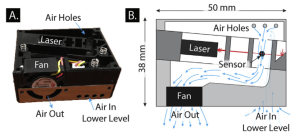More Information on Air Pollution and Wildfires
What is Purple Air?

The Purple Air monitor at HHSB
Purple Air is a low-cost (~$250) air pollution sensor that measures particulate matter, temperature, and relative humidity. Particulate matter concentrations are measured by a PMS sensor like the one below using laser light scattering technology.
What is particle pollution?

A diagram of different sizes of particulate matter.
Particle pollution, also called particulate matter or aerosols are suspended units of conglomerated solid and/or liquid material in the air.
Sources of particulate matter on campus may include:
-
-
- Vehicle exhaust
- Cigarette and vape smoke
- Construction dust
- Pollen
- Cooking emissions
- Wood burning stoves
- Prescribed burn and wildfire smoke
- Reactions in the atmosphere from gases released from trees (called secondary organic aerosol)
-
Click the button below to learn more.
More About Local Wildfires
Wildfires can affect the quality of our environmental health through:
- unhealthy air pollutants
- water contamination
Climate change is a large contributing factor to recent wildfires. The change in our climate is leading to increased heat, extended droughts, and a lack of moisture in out atmosphere which in turn is causing an increase of wildfires and how extreme they are.
Click the buttons below to learn more about wildfires burning localy, in Western North Carolina, and across the United States and how they can affect the air quality.

Photo via U.S. Foresty Service/NC Forest Service: October 23, 2023, from the Collett Ridge Fire in the Nantahala National Forest


